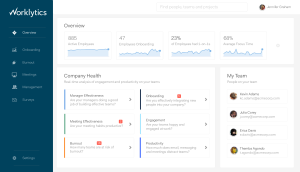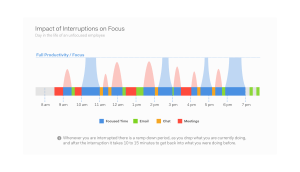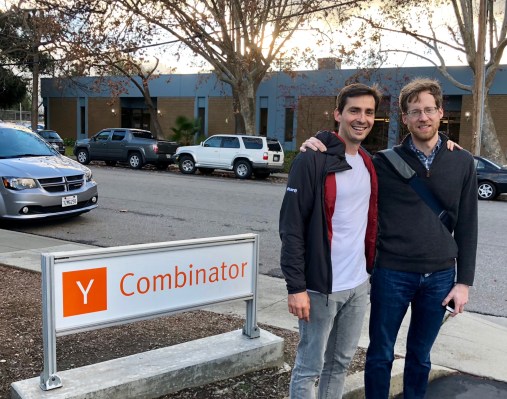If you’ve ever been stuck in a boring meeting, chances are you might spend the time busy answering messages from email or Slack — or even just browsing around the Internet while you wait for it to finally end.
And there are a lot of factors that go into making that meeting boring, from the content to the person actually delivering it. Phillip Arkcoll knows that problem quite well, and he sought to figure out a way to not only find a way to make meetings better and more efficient, but try to help those teams become more efficient altogether. That’s why he and his co-founder Erik Schultink started Worklytics, a tool to figure out how well people are working across collaboration platforms like Jira, Github, and of course meetings. The goal of the tool is to figure out what’s working on what teams, and then offer some insight to the company on how to figure out how to keep doing that across the board. Worklytics is coming out of Y Combinator’s winter class this year.
“A lot of the collaboration and work people were doing was happening across all these platforms,” Arkcoll said. “At that time we started to think, as we’re scaling, how can we get more visibility into what’s happening across the organization. We can make sure people are getting the right feedback. We started working then on what sorts of insights we could pull out from all the data. We’d heard [larger] companies were investing a lot in this type of technology — analyzing data on what makes great teams and great managers. We wanted to productize that data, put that into a tool, and start to give you feedback on how to improve the employee experience based on what that experience is like at the team level.”

One of the key components of Worklytics is identifying great managers that are operating their teams smoothly, regularly hitting and surpassing targets and offering employees a great experience that helps them feel like they are growing. If a team — the data that Worklytics is anonymized and not on a per-employee basis — is doing well, they can find ways to adapt and help their employees continue to grow and nurture the talent internally with the help of these good managers. That can mean they are keeping their teams happy, not having boring meetings, and altogether just getting things done. Worklytics plugs into a few dozen apps in order to figure out a number of factors, such as whether code is getting reviewed and employees are getting regular feedback.
“The manager’s job is to listen and provide feedback, keep them on track and get them focused and motivated,” Arkcoll said. “I’ve seen a lot of companies break down because there isn’t that good feedback loop. People think, oh I’m talking informally, so that’s enough. But if you don’t set out time to really do that, it’s not going to help. If you have an organization with ten managers under you, how are you making sure all ten are having one-on-ones on a regular basis, that it’s happening with people across the organization, and that people are getting feedback. That’s a super common issue, it’s really simple, but that also doesn’t often happen.”

To be sure, the tools don’t stalk employees like a hawk. They aren’t checking whether you’re logging onto Facebook or casually browsing the Internet — after all, a lot of employees get most of their work done in very little time, though they still spend their typical eight hours or so a day at work, Arkcoll said. The goal is to figure out whether employees are spending time wisely across those collaboration apps, find choke points that they can improve (such as flagging managers that there aren’t enough one-on-ones), and generally empowering companies to help managers take on the best practices that in turn help their employees.
Arkcoll said part of the idea for he and Schultink stemmed from their own experience scaling up companies, where these kinds of processes can break down without the proper management layers coming in. As companies get bigger and bigger, the scope of the work grows ever wider, and a lot can get lost in communication through collaboration tools. It’s the job of those in-the-middle managers to make sure everything is running smoothly and the team is performing — and employees feel like they’re growing.
And if the feedback loops aren’t in place, like one-on-ones or code review, then employees might feel like they aren’t developing their skills (or actually aren’t), and more and more tools introduce more and more noise. Worklytics tries to identify those disruptions and noise through those integrations, and find what’s working and what isn’t working. “If you’re a knowledge worker you need to have periods of uninterrupted time to get work done,” Arkcoll said.
As a tool like Worklytics gets more and more data across what works — Arkcoll says, again, this is at a team level and anonymized — it can distill down best practices that might work across multiple companies in the same space or even generally. But that also means that larger companies with direct access to this kind of data might start to go after these kinds of tools, such as something from Microsoft. There are also some startups like StatusToday emerging to try to target something similar, though they all have their own flavors of approaching the problem. In the end, it’s going to come down to having the right goals set for the tools and convincing companies that they have the data to figure out the best practices, as well as what’s best for employees.
“I think in the industrial age people thought about productivity inside of factories, I don’t think that makes sense,” Arkcoll said. “It’s not about are you cranking widgets or work on a continuous basis, measuring that doesn’t make sense. Trying to give people that kind of feedback isn’t really helpful and can be demotivating. We don’t think that’s a good idea. What we’re focused on are companies creating a great environment for people that allows them to get work done, get the information, and get access to managers and get feedback. You can hire the best people but if they don’t have the right environment to work in they’re not gonna see results. That’s what we’re trying to do rather than watch how many widgets people are pumping out.”
